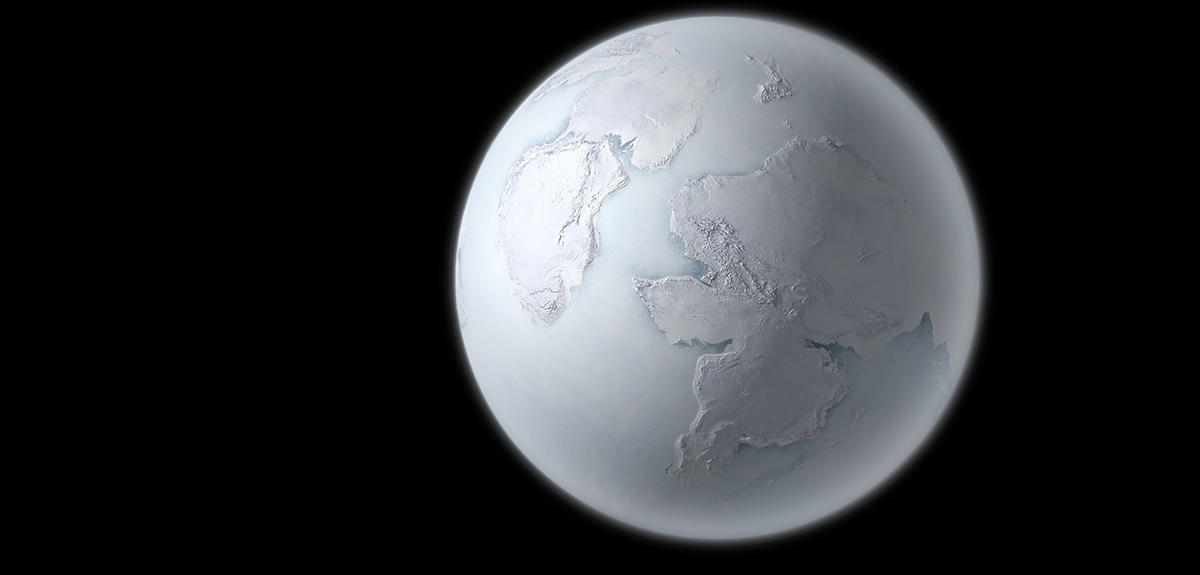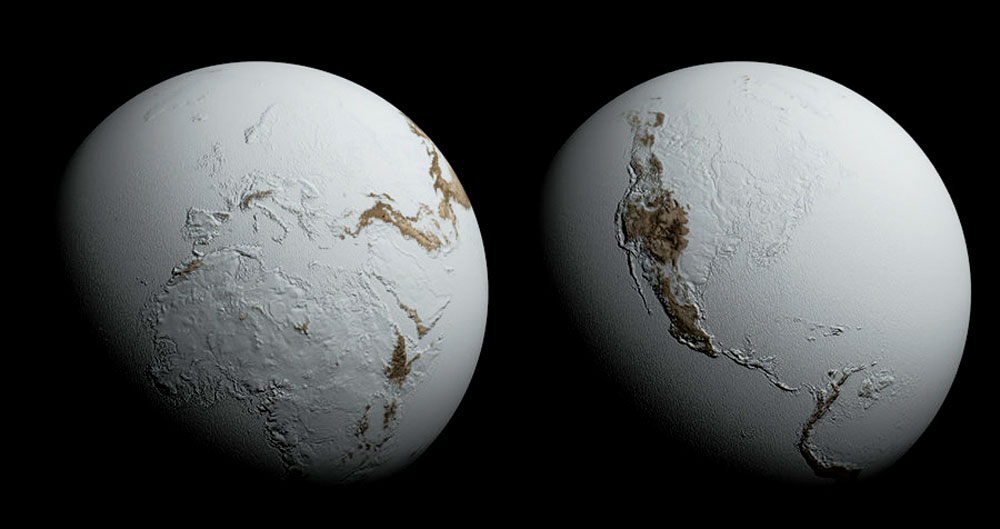“The Proterozoic Eon is a sweep of time beginning when the Earth was 2.5 billion years old and ending when the Earth was 542 million years. During the first 500 million years, cyanobacteria and photosynthesis were invented which oxygenated the world. The proceeding one billion years was a time of enigmatic calm as the Earth did not change much. But in the last roughly 350 million years, the Earth’s systems were spun into a whirlwind. The Earth experienced one of the most dramatic series of ice ages in its history and turned into a giant, white, ice ball. But after these ice ages ended, a second great oxidization event occurred. The last step was taken in the march from the simple to the complex: there was finally enough oxygen to support large, multi-cellular creatures and the Ediacaran fauna emerged.”
Breakup of Rodinia
The Proterozoic Eon is a stretch of time which began 2.5 billion years ago and ended 542 million years ago. The first 500 million years kicked off with cyanobacteria causing the Great Oxidization Event (GOE) which transformed the Earth's chemistry and geology as discussed in the article on Early Earth History. The next billion years—the so-called 'boring billion'—was a time of enigmatic calm and stability. Despite the continents drifting across the world and super continents merging and breaking apart during this time, in many respects this one billion years was, well, pretty boring: the Earth's climate and oceanic and atmospheric chemistry did not change much, there were no great ice ages, and no major evolutionary innovations in the existing life on Earth. But how did the Earth sustain such equilibrium over these one billion years? The answer is that the Earth's various systems (i.e. climate, oceans, land masses, etc.) are highly interconnected and in constant interplay; the Earth's equilibrium was sustained over this time through negative feedback loops between these systems. An example of one of these negative feedback loops which occurred during the boring billion (and which still occurs today) is the following: as the Earth's oceans warm, this leads to more cloud formation in the atmosphere which reflects more of the Sun's solar radiation and heat back into space causing the oceans to cool back down. Here's another example: when the amount of carbon dioxide in the atmosphere increases, the Earth's temperature increases; but when the amount of carbon dioxide increases in the atmosphere, the amount of denudation of rocks along coastlines increases, and those minerals which get abraded off coastlines soak up carbon dioxide and cause the Earth's temperature to fall back down.
Picture of Earth 750 million years ago when the supercontinent Rodinia was getting torn apart. (Click to expand.)
This period of equilibrium was broken roughly during the time interval of 850-750 million years ago when Rodinia gradually rifted apart; this caused the Earth's various systems, especially the climate, to fluctuate wilder than perhaps any other time in Earth history. This break up was gradual and the first rift occurred 850 million years ago when the Congo and Kalahari cratons rifted apart; and the second rift occurred about 800 million years ago when the West African craton broke off Rodinia. These rifts had only a mild effect at best on Earth's systems. But 750 million years ago, the third rift occurred which, basically, tore Rodinia in half: East Antarctica and Australia rifted apart from Laurentia along the magenta line in the figure on the right. (This third rift is also shown visually in the video below.) This rift was so extraordinary that it cracked open the Earth's crust and exposed lava in the upper mantle.
Ancient times and ancient continents. This animation shows the movements of Rodinia (1100Ma - 750Ma) and Pannotia (600Ma - 560Ma) during the late Precambrian (Neoproterozoic) and early Paleozoic (up to 400Ma). Rodinia broke apart as a result of its collision with the Congo craton (~750Ma).\(^{[1]}\)
Snowball-hothouse cycle
When Rodinia split apart, thousands of miles of new coastlines were created and the rate at which minerals were abraded off of the coastal surfaces also increased. Before this event, photosynthetic algae were starving of nutrients; but after this event, algae had a rather enormous supply of nutrients. This allowed them to flourish and proliferate leading to large algal blooms all over the world. These algae are photosynthetic factories that absorb carbon dioxide and pump out oxygen. The more algae there is, the more carbon dioxide gets soaked up and the more oxygen gets produced.
Now, usually, the input and output of carbon dioxide into the Earth's atmosphere is balanced and in equilibrium due to negative feedback loops; but during this time, all of this new algae began to absorb so much carbon dioxide that it nullified the negative feedback loops that once kept the amount of atmospheric carbon dioxide stable. There was a runaway effect where the algae kept pulling carbon dioxide out of the atmosphere causing the Earth to have less and less greenhouse gases to "trap" the Sun's solar energy; the Earth, not being able to trap heat as effectively, gradually cooled. (This was likely exasperated by the fact that most of the land masses were around the equator. Land has a higher albedo than water—which is just a fancy way of saying that land does a better job at reflecting solar radiation (and hence a worse job at absorbing solar radiation) than does water.) We can conclude from observation (specifically, from the presence of tillites near the equator which we'll discuss in a separate lesson) that these factors which cooled the planet must have not only nullified negative feedback loops sustaining climatic stability, but must have also lead to an epic ice age which lasted for millions of years.
As greenhouse gases such as carbon dioxide got pulled out of the atmosphere by abraded minerals and stupendously large colonies of algae (among other possible factors), ice caps started to form at the poles. This initiated a positive feedback loop. The ice reflected the Sun's radiation causing the Earth to get even cooler; since the Earth got cooler, more ice spread out; and since more ice spread out, more solar radiation got reflected causing the Earth to get colder still; and so on. To what extant did this "ice spreading" continue? In 1998, the geologist Paul Hoffman and his three colleagues published a paper entitled, "A Neoproterozoic Snowball Earth," which shocked the scientific community by proposing something that many scientists initially thought was impossible. They argued for what is now called the "hard snowball" version of the Snowball Earth hypothesis which asserts that this ice continued to spread until eventually the entire surface of the planet was covered in ice, even along the equator. According to this view, average global temperatures plummeted to -50 degrees Fahrenheit as the entire Earth essentially turned into a giant, white ice ball with a layer of ice up to a mile thick engulfing the entire planet. Although there is good evidence that this happened, most scientists now accept the less extreme "slush snowball" version of Snowball Earth. This position asserts that most of the Earth must have had been covered in ice but that there were still some open, liquid seas.
What happened next was the Earth went from being a giant ice ball to a hothouse. The ice sheets did not effect volcanic activity. Volcanoes, which were popping out of the icy surfaces, continued to pour carbon dioxide into the atmosphere. But there were no coastal minerals or large algae blooms to soak it up. As a result of this, carbon dioxide continued to build up in the atmosphere until, eventually, the amount of carbon dioxide in the atmosphere reached levels which were perhaps thousands of times greater than they are today. The Sun's solar energy still bounced off of the ice, but the enormous amount of carbon dioxide caused much of that solar radiation to bounce back to hit the ice again. This melted some of the ice—but the result of some of the ice getting melted initiated a positive feedback loop and domino effect. As some of the ice melted, a portion of the Earth's land or sea got revealed which was able to absorb more solar radiation than ice causing the planet to warm; but as the planet warmed, more ice melted causing more solar radiation to get absorbed since more land and ocean was revealed, leading to the planet getting warmer still; and so on. This positive feedback loop, along with other possible factors, continued to heat the Earth until the temperatures of the Earth soared to record highs.
As the Earth's temperatures soared to record highs, acid rainfall struck the Earth's surface leading to the rapid erosion of the then exposed rocks along the coasts of landmasses. These minerals fell into the ocean providing nutrients for algae causing another algae bloom. All of this algae began to soak up the carbon dioxide causing the Earth to cool again. We're basically right back we're we started a few paragraphs ago: the same glaciation effect and subsequent hothouse Earth happens just as before. This cycle of glaciations and hothouses occurred three times over the next 150 million years. But after the third cycle, the dust settled and Snowball-hothouse Earth finally reached a steady, moderate climate.
During this time, cyanobacteria poured so much oxygen into the atmosphere that the amount of oxygen in Earth's atmosphere reached roughly 20%—close to present-day levels. There was finally enough oxygen to support large, multi-cellular creatures and the Ediacaran fauna emerged.
This article is licensed under a CC BY-NC-SA 4.0 license.
References
1. Christopher Scotese. "Precambrian Animation by CR Scotese". Online video clip. YouTube. YouTube, 07 June 2017. Web. 12 June 2017.
2. Hazen, Robert. The Story of Earth: The First 4.5 Billion Years, from Stardust to Living Planet. New York: Random House, 2012. Print.



